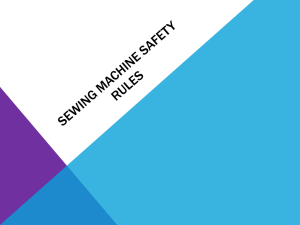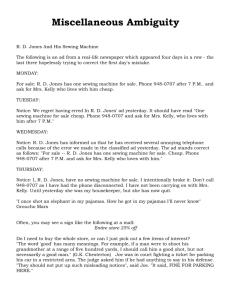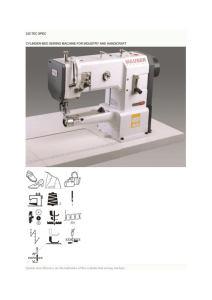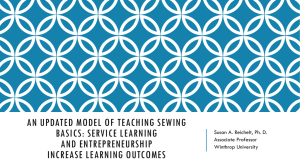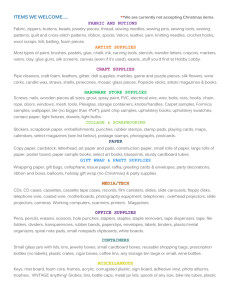How do sewing machines work?
advertisement
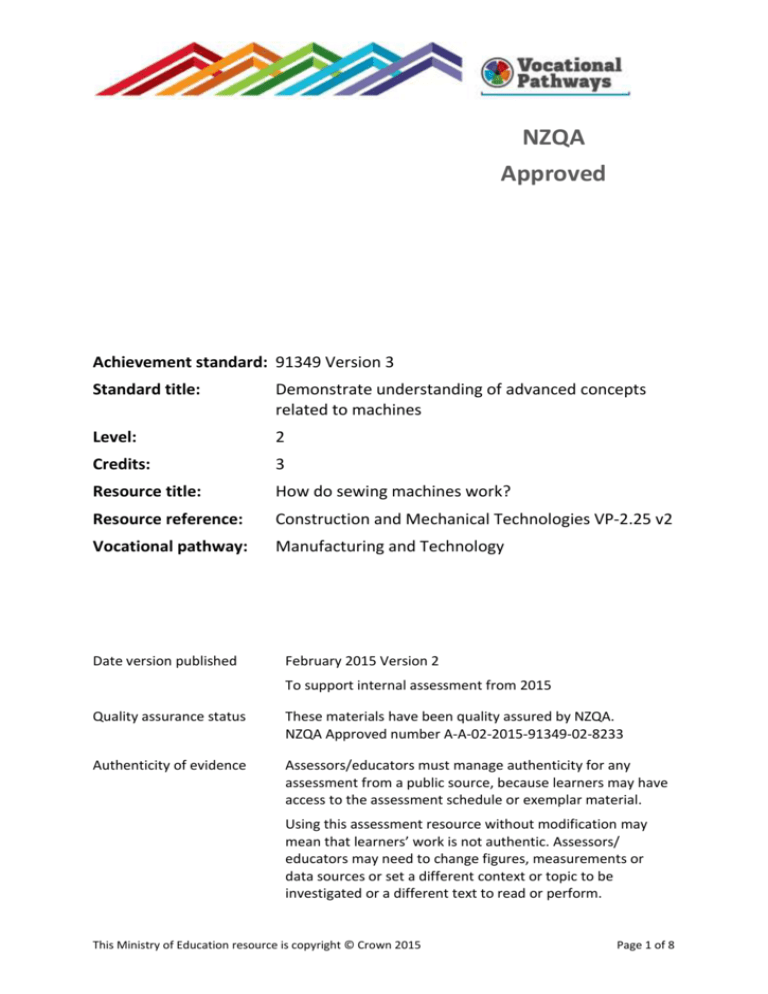
NZQA Approved Achievement standard: 91349 Version 3 Standard title: Demonstrate understanding of advanced concepts related to machines Level: 2 Credits: 3 Resource title: How do sewing machines work? Resource reference: Construction and Mechanical Technologies VP-2.25 v2 Vocational pathway: Manufacturing and Technology Date version published February 2015 Version 2 To support internal assessment from 2015 Quality assurance status These materials have been quality assured by NZQA. NZQA Approved number A-A-02-2015-91349-02-8233 Authenticity of evidence Assessors/educators must manage authenticity for any assessment from a public source, because learners may have access to the assessment schedule or exemplar material. Using this assessment resource without modification may mean that learners’ work is not authentic. Assessors/ educators may need to change figures, measurements or data sources or set a different context or topic to be investigated or a different text to read or perform. This Ministry of Education resource is copyright © Crown 2015 Page 1 of 8 Internal assessment resource: Construction and Mechanical Technologies VP-2.25 v2 – Vocational pathway: Manufacturing and Technology PAGE FOR LEARNER USE Vocational Pathway Assessment Resource Achievement standard: 91349 Standard title: Demonstrate understanding of advanced concepts related to machines Level: 2 Credits: 3 Resource title: How do sewing machines work? Resource reference: Construction and Mechanical Technologies VP-2.25 v2 Vocational pathway: Manufacturing and Technology Learner instructions Introduction This assessment activity requires you to create a presentation that demonstrates your understanding of advanced concepts related to sewing machines. You are going to be assessed on how comprehensively you demonstrate your understanding of advanced concepts related to sewing machines. You need to show that you are able to process and interpret information, and prepare a presentation that includes why mechanical components are combined in sewing machines to provide mechanical advantage, relative motion between input and output, and the desired efficiency. The following instructions provide you with a way to structure your work so you can demonstrate what you have learnt and achieve success in this standard. Assessor/educator note: It is expected that the assessor/educator will read the learner instructions, and modify them if necessary to suit their learners. Task Create a presentation in which you do the following: Explain how mechanical components are combined in sewing machines. Describe the efficiencies of sewing machines in relation to their safe use. You could describe: - the efficiency of the sewing machine or a selection of sewing machine components, such as the transfer of energy from the upper driveshaft to the lower driveshaft, and describe a ratio calculated by output energy divided by input energy - how the connected driveshafts result in a safe and efficient transfer of motion and energy. Discuss why mechanical components were combined in the way they are in sewing machines, and how this enables them to achieve mechanical advantage, relative motion between input and output, and the required efficiency. You could: This Ministry of Education resource is copyright © Crown 2015 Page 2 of 8 Internal assessment resource: Construction and Mechanical Technologies VP-2.25 v2 – Vocational pathway: Manufacturing and Technology PAGE FOR LEARNER USE - discuss how the rotary input motion from the electric motor which drives the machine is converted by components such as driveshafts, crankshafts, gears and pulleys to produce the final reciprocating motion required by the sewing machine needle - compare and contrast other components that could be used to achieve the same (or a better) mechanical advantage - discuss desired efficiency calculated in terms of the ratio between outputs achieved, and input that enable such things as the needle to drive up and down, different stitches to be achieved or the fabric to be pulled through - discuss how variations in mechanical advantage and efficiencies are achieved that account for changes in gear and feed timing to enable changes in fabrics being used (for example thick, sheer, stretch), and the required effect (for example seam and/or hem finishes, embellishments, zips). Include in your presentation: annotated photos, drawings, and/or pictures tables and/or flow charts website links practical demonstrations or show models. Collect evidence that explains the relevant concepts, for example annotated sketches, mock-ups, models, photographs, quotes. Keep a record of all sources so that you can acknowledge them in your presentation. This Ministry of Education resource is copyright © Crown 2015 Page 3 of 8 Internal assessment resource: Construction and Mechanical Technologies VP-2.25 v2 – Vocational pathway: Manufacturing and Technology PAGE FOR LEARNER USE Resources Resource A: Definitions These definitions are reprinted from the standard (Construction and Mechanical Technologies 91349). For the purposes of this standard, a machine will include two or more mechanical components. Mechanical components include: Cams and followers. These include (but are not limited to) cams such as plate and eccentric; followers such as needle, roller, flat, offset. Pivots and linkages. These include (but are not limited to) pivots such as fixed and moving; linkages such as: parallel, reverse, and sliding crank motion. Gears include (but are not limited to) spur, bevel, helical, rack and pinion, worm, idler Belt or chains and sprockets include (but are not limited to) flat belt, v-belt, duplex chain or double belt, tooth belt. Shafts and bearings include (but are not limited to) solid shafts, hollow shafts, ball bearing, roller bearing, and conical bearing. A machine’s efficiency is determined by the ratio of the energy delivered (or work done) by the machine to the energy needed (or work required) to operate it (i.e. output energy/input energy). Resource B: Useful websites http://electronics.howstuffworks.com/tech http://www.technologystudent.com/ http://www.fi.edu/qa97/spotlight3/ This Ministry of Education resource is copyright © Crown 2015 Page 4 of 8 Internal assessment resource: Construction and Mechanical Technologies VP-2.25 v2 – Vocational pathway: Manufacturing and Technology PAGE FOR ASSESSOR/EDUCATOR USE Vocational Pathway Assessment Resource Achievement standard: 91349 Standard title: Demonstrate understanding of advanced concepts related to machines Level: 2 Credits: 3 Resource title: How do sewing machines work? Resource reference: Construction and Mechanical Technologies VP-2.25 v2 Vocational pathway: Manufacturing and Technology Assessor/Educator guidelines Introduction The following guidelines are supplied to enable assessors/educators to carry out valid and consistent assessment using this internal assessment resource. As with all assessment resources, education providers will need to follow their own quality control processes. Assessors/educators must manage authenticity for any assessment from a public source, because learners may have access to the assessment schedule or exemplar material. Using this assessment resource without modification may mean that learners' work is not authentic. The assessor/educator may need to change figures, measurements or data sources or set a different context or topic. Assessors/educators need to consider the local context in which learning is taking place and its relevance for learners. Assessors/educators need to be very familiar with the outcome being assessed by the achievement standard. The achievement criteria and the explanatory notes contain information, definitions, and requirements that are crucial when interpreting the standard and assessing learners against it. Context/setting This activity requires learners to demonstrate comprehensive understanding of advanced concepts related to sewing machines. Conditions The learners could gather and analyse their evidence independently or in groups, but they need to create their presentation independently, and will be assessed individually. Decide on the format of the final presentation. You may wish to take learners’ preferences into account in deciding on the format. Resource requirements The assessor/educator will provide opportunities for learners to develop their evidence. This Ministry of Education resource is copyright © Crown 2015 Page 5 of 8 Internal assessment resource: Construction and Mechanical Technologies VP-2.25 v2 – Vocational pathway: Manufacturing and Technology PAGE FOR ASSESSOR/EDUCATOR USE Learners require access to: the internet for research a camera, presentation materials (for example paper, modelling materials), printer, computer, data projector and/or flow charts. Additional information None. Other possible contexts for this vocational pathway Demonstrating understanding of advanced concepts relating to any machines used in the manufacturing and technology sector, for example aeroplanes and their associated machinery, machines used for assembly of electronics or machines used in food technology. This Ministry of Education resource is copyright © Crown 2015 Page 6 of 8 Internal assessment resource: Construction and Mechanical Technologies VP-2.25 v2 – Vocational pathway: Manufacturing and Technology PAGE FOR ASSESSOR/EDUCATOR USE Assessment schedule: Construction and Mechanical Technologies 91349 – How do sewing machines work? Evidence/Judgements for Achievement Evidence/Judgements for Achievement with Merit Evidence/Judgements for Achievement with Excellence The learner demonstrates understanding of advanced concepts related to sewing machines by: explaining how mechanical components are combined to form sewing machines For example, the learner: - includes annotated diagrams and/or photographs that identify the sewing machine components, their position within the machine, and an explanation of how they work together to produce a desired output; parts could include motor, drive wheel, driveshaft, needle bar, needle bar connecting arm, cams, gears, pulleys, pivots and links. describing the efficiencies of sewing machines in relation to their safe application For example, the learner describes: - the efficiency of the sewing machine or a selection of sewing machine components such as the transfer of energy from the upper driveshaft to the lower driveshaft, and describes a ratio calculated by output energy divided by input energy - how the efficiencies of the connected driveshafts result in a safe transfer of energy. explaining how mechanical components are The learner demonstrates in-depth understanding of advanced concepts related to sewing machines by: explaining how mechanical components are combined to form sewing machines For example, the learner: - includes annotated diagrams and/or photographs that identify the sewing machine components, their position within the machine, and an explanation of how they work together to produce a desired output; parts could include motor, drive wheel, driveshaft, needle bar, needle bar connecting arm, cams, gears, pulleys, pivots and links. describing the efficiencies of sewing machines in relation to their safe application For example, the learner describes: - the efficiency of the sewing machine or a selection of sewing machine components such as the transfer of energy from the upper driveshaft to the lower driveshaft, and describes a ratio calculated by output energy divided by input energy - how the efficiencies of the connected driveshafts result in a safe transfer of energy. explaining how, in a particular sewing The learner demonstrates comprehensive understanding of advanced concepts related to sewing machines by: explaining how mechanical components are combined to form sewing machines For example, the learner: - includes annotated diagrams and/or photographs that identify the sewing machine components, their position within the machine, and an explanation of how they work together to produce a desired output; parts could include motor, drive wheel, driveshaft, needle bar, needle bar connecting arm, cams, gears, pulleys, pivots and links. describing the efficiencies of sewing machines in relation to their safe application For example, the learner describes: - the efficiency of the sewing machine or a selection of sewing machine components such as the transfer of energy from the upper driveshaft to the lower driveshaft, and describes a ratio calculated by output energy divided by input energy - how the efficiencies of the connected driveshafts result in a safe transfer of energy. discussing why, in a particular sewing machine, This Ministry of Education resource is copyright © Crown 2015 Page 7 of 8 Internal assessment resource: Construction and Mechanical Technologies VP-2.25 v2 – Vocational pathway: Manufacturing and Technology PAGE FOR ASSESSOR/EDUCATOR USE combined to transfer work and motion in sewing machines For example, the learner: - uses diagrams and annotations to explain how the motor is controlled by a foot pedal, which lets the user vary the speed easily - shows how everything is linked together, so when the pedal is pressed the motor speeds all of the processes up at the same rate - explains how the process is always perfectly synchronized, no matter how fast the motor is turning. The above expected learner responses are indicative only and relate to just part of what is required. machine, mechanical components combine to provide the desired mechanical advantage, and relative motion between input and output For example, the learner: - includes diagrams and/or photographs with annotations and calculations to explain the mechanical advantage achieved between inputs and different outputs. This could include an explanation of how the rotary input motion from the electric motor which drives the machine is converted by components such as driveshafts, crankshafts, gears and pulleys to produce the final reciprocating motion required by the sewing machine needle. The above expected learner responses are indicative only and relate to just part of what is required. mechanical components were combined the way they were to provide the desired mechanical advantage, relative motion between input and output, and efficiency For example, the learner discusses: - why the components were combined the way they were to achieve mechanical advantage, including diagrams and/or photographs with annotations and calculations - consideration of other components that could have been used to achieve the same (or a better) mechanical advantage - the efficiency desired, in terms of the ratio between outputs achieved and input effort, that enable such things as the needle to drive up and down, different stitches to be achieved, and the fabric to be pulled through - how variations in mechanical advantage and efficiencies are achieved that account for changes in fabrics being used (e.g. thick, sheer, stretch), and the required effect (e.g. seam and/or hem finishes, embellishments, zips). The above expected learner responses are indicative only and relate to just part of what is required. Final grades will be decided using professional judgement based on an examination of the evidence provided against the criteria in the Achievement Standard. Judgements should be holistic, rather than based on a checklist approach. This Ministry of Education resource is copyright © Crown 2015 Page 8 of 8
